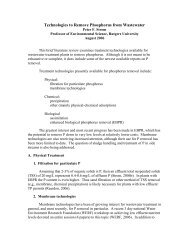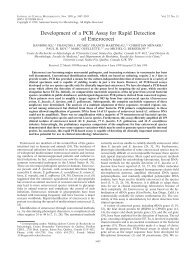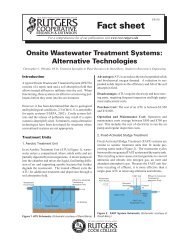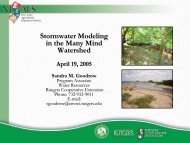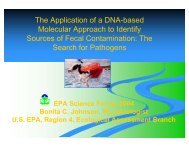Septic Systems 101 - State of New Jersey
Septic Systems 101 - State of New Jersey
Septic Systems 101 - State of New Jersey
You also want an ePaper? Increase the reach of your titles
YUMPU automatically turns print PDFs into web optimized ePapers that Google loves.
<strong>Septic</strong> <strong>Systems</strong> <strong>101</strong>:<br />
A Primer to Understanding Your<br />
Individual Subsurface Sewage Disposal System (ISSDS)<br />
Introduction:<br />
In general, a contemporary septic system consists <strong>of</strong> two basic units (Figures 1 & 2): an<br />
underground septic tank (Primary Treatment Unit) and a soil absorption area or drainage field<br />
(Secondary Treatment Unit) with a distribution box that connects the two and disperses the septic<br />
tank effluent evenly over a properly sized absorption area. The septic tank itself is a durable,<br />
watertight container that is resistant to corrosion or decay, e.g., concrete, plastic or fiberglass.<br />
The soil absorption field is typically a network <strong>of</strong> perforated piping laid-out in trenches filled<br />
with a filtering medium such as gravel, crushed stone or sand.<br />
Figure 1. Typical, double-chamber septic tank depicting various features (NJDEP).<br />
The septic tank serves as a settling basin: heavy solid wastes (sludge) sink to the bottom <strong>of</strong> the<br />
tank where microbial action will ultimately reduce it by as much as 50% over time; and lighter<br />
solids, e.g., grease, toilet paper, and hair, rise to the surface to form a floating layer <strong>of</strong> scum<br />
(Figure 1). A typical septic tank will “hold” the wastewater for at least 24 hours to provide<br />
adequate time for separation and settling. The “clarified” water between the sludge and scum<br />
layers then enters the distribution box and is discharged into the drainage field where it is further<br />
purified as it moves through the filtering beds and soil pr<strong>of</strong>ile. The septic tank is specifically<br />
designed to aid the separation process: inlet baffles or tees direct the household discharges<br />
downward to the bottom <strong>of</strong> the tank, which prevents the wastewater from flowing straight across<br />
the tank to the outlet end and concurrently minimizes splashing and resuspension <strong>of</strong> settled<br />
solids. An outlet baffle or tee is also incorporated to contain the scum layer and prevent it from<br />
entering the disposal field. Removing solids prior to the release <strong>of</strong> effluent protects the soil<br />
absorption system from clogging and failure.
Why are regular pump-outs so important<br />
Inside the septic tank between the accumulating layers <strong>of</strong> scum and sludge is a volume <strong>of</strong> water<br />
available for the separation and settling <strong>of</strong> these discharge components, called the “net free area.”<br />
As time goes by, this net free area becomes progressively smaller as the layers <strong>of</strong> sludge and<br />
scum grow thicker towards each other, until eventually it lacks the volume necessary to provide<br />
adequate time for separation and settling. As the movement <strong>of</strong> household discharges continues<br />
in its typical rhythm, unseparated sewage will start entering the dispersal area where the<br />
perforated pipes and filtering beds are highly susceptible to coating and clogging (Figure 3). If a<br />
septic tank isn’t pumped out regularly these compromises will begin and quickly accrue, and this<br />
damage will be occurring long before any foul odors result or sewage backs up in the home or<br />
yard. At best, such compromises will reduce the system’s effectiveness and shorten the lifespan<br />
<strong>of</strong> the soil absorption area. At worst, the system will ultimately fail altogether, costing thousands<br />
<strong>of</strong> dollars to repair or replace. In addition, older systems may lack the components described for<br />
contemporary systems, such as baffles and tees, making regular pump-outs even more essential<br />
to prevent disposal area clogging and failure.<br />
Figure 2.<br />
Typical disposal field for an Individual Subsurface Sewage Disposal System (NJDEP).<br />
How <strong>of</strong>ten should a septic system be pumped-out<br />
How <strong>of</strong>ten a septic tank should be pumped-out depends on several variables such as tank size,<br />
number <strong>of</strong> persons in the household, and whether a garbage disposal or grinder is incorporated<br />
into the system. While different sources vary somewhat in their time-frame recommendations,<br />
2
typical recommended pump-out frequencies are about once every 3 years for a 1,000 -1,250<br />
gallon tank serving a family <strong>of</strong> 4. A table that provides pump-out recommendations based on<br />
tank and household size is provided in the Rutger’s Cooperative Research & Extension Fact<br />
Sheet (FS840), Onsite Wastewater Treatment <strong>Systems</strong>: The Maintenance and Care <strong>of</strong> Your<br />
<strong>Septic</strong> System. The web link to access this fact sheet as well as other resources are provided<br />
below.<br />
Figure 3. The materials captured in this effluent filter effectively depict what will enter and<br />
accrue in the disposal field <strong>of</strong> an improperly maintained ISSDS (NJDEP).<br />
It is important to note that garbage disposals increase the volume <strong>of</strong> solids discharged into the<br />
septic tank by as much as 50% and consequently require more frequent pump-outs. Strategies to<br />
address the additional organic wastes produced through the use <strong>of</strong> a garbage disposal include<br />
increasing the frequency <strong>of</strong> pumping (for example, see www.tctcwa.org and www.inspectny.com/septbook.htm<br />
) and treating an installed garbage disposal as though it were an additional<br />
person living in the household, e.g., a 3-person household using a garbage disposal would be<br />
pumped out as <strong>of</strong>ten as is indicated for a 4-person household with the same size septic tank (see<br />
the <strong>New</strong> York <strong>Septic</strong> Code at Section 75-A.6). In <strong>New</strong> <strong>Jersey</strong>, pursuant to the Standards for<br />
Individual Subsurface Sewage Disposal <strong>Systems</strong> at N.J.A.C. 7:9A-8.2(c), ISSDSs installed<br />
concurrently with a garbage disposal require a double-compartment tank which must be sized<br />
50% larger than that required without a garbage disposal. In addition, at N.J.A.C. 7:9A-10.2(c),<br />
Table 10.2(c), the disposal field must be 25% larger than that required without a garbage grinder.<br />
3
Many ISSDSs will have been installed prior to the above precautionary requirements, however,<br />
and the selected pumping frequency should be selected to account for the added loading.<br />
Conclusion:<br />
Malfunctioning septic systems can contaminate both ground and surface waters, creating health<br />
risks to humans and impairing natural ecosystems. Pumping out the septic tank on a regular<br />
basis is the single most significant step that can be taken to extend the system’s effective lifespan<br />
and protect the surrounding environment. A small investment in preventative maintenance can<br />
avert an expensive repair. Compare the typical $200.00 - $400.00 to have a septic tank pumped<br />
out with the also typical $3,000.00 - $10,000 to repair or replace major system components.<br />
References/Resources<br />
This paper is based on a variety <strong>of</strong> resources such as those listed below. For more detail on any<br />
<strong>of</strong> the aspects noted, each <strong>of</strong> the following is available by clicking on the associated link.<br />
Rutgers Cooperative Research & Extension. 2005. Onsite Wastewater Treatment <strong>Systems</strong>: the<br />
Maintenance and Care <strong>of</strong> Your <strong>Septic</strong> System. Fact Sheet FS840. The <strong>State</strong> University <strong>of</strong> <strong>New</strong><br />
<strong>Jersey</strong>. www.water.rutgers.edu (Click on Fact Sheets)<br />
Rutgers Cooperative Research & Extension. 2005. Onsite Wastewater Treatment <strong>Systems</strong>:<br />
Operating Permits. Fact Sheet FS533. The <strong>State</strong> University <strong>of</strong> <strong>New</strong> <strong>Jersey</strong>.<br />
www.water.rutgers.edu (Click on Fact Sheets)<br />
Rutgers Cooperative Research & Extension. 2005. Onsite Wastewater Treatment <strong>Systems</strong>:<br />
Five Levels <strong>of</strong> Protection. Fact Sheet FS531. The <strong>State</strong> University <strong>of</strong> <strong>New</strong> <strong>Jersey</strong>.<br />
www.water.rutgers.edu (Click on Fact Sheets)<br />
Rutgers Cooperative Research & Extension. 2005. Onsite Wastewater Treatment <strong>Systems</strong>:<br />
Accessorizing Your <strong>Septic</strong> System. Fact Sheet FS532. The <strong>State</strong> University <strong>of</strong> <strong>New</strong> <strong>Jersey</strong>.<br />
www.water.rutgers.edu (Click on Fact Sheets)<br />
The Home Inspection & Construction Website @ http://www.inspectny.com/septic/tankpump.htm<br />
The Tobyhanna Creek/Tunkhannock Creek Watershed Association @<br />
http://www.tctcwa.org/html/body_septic.htm<br />
4



